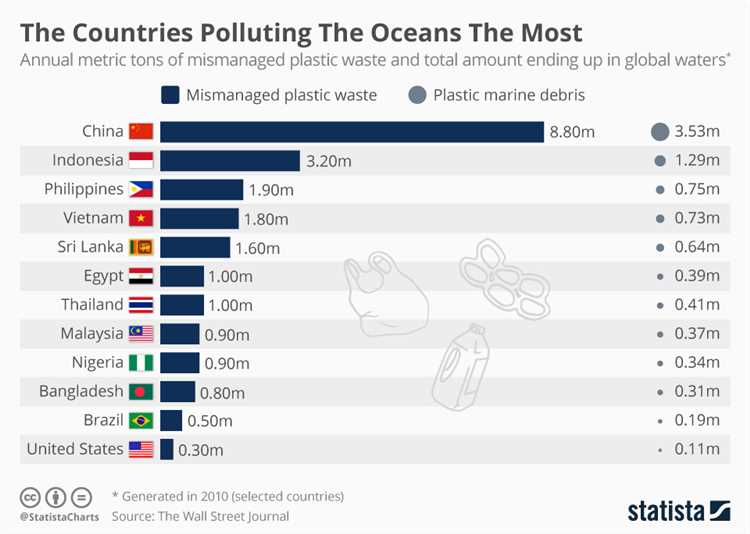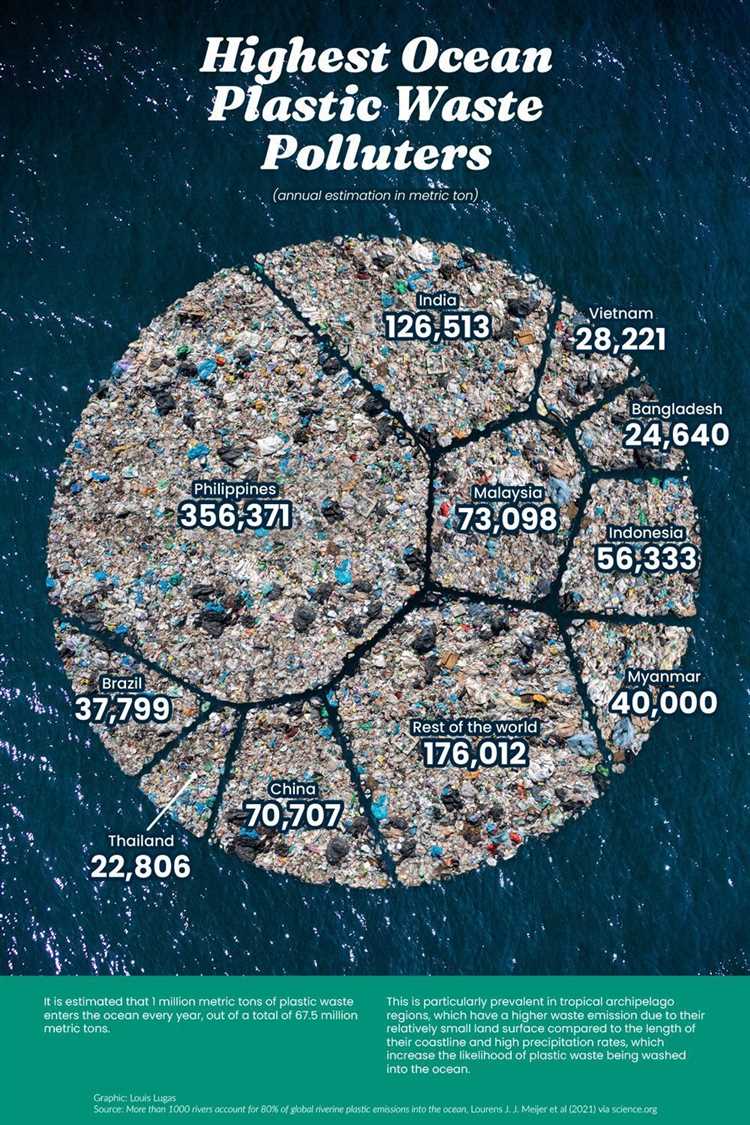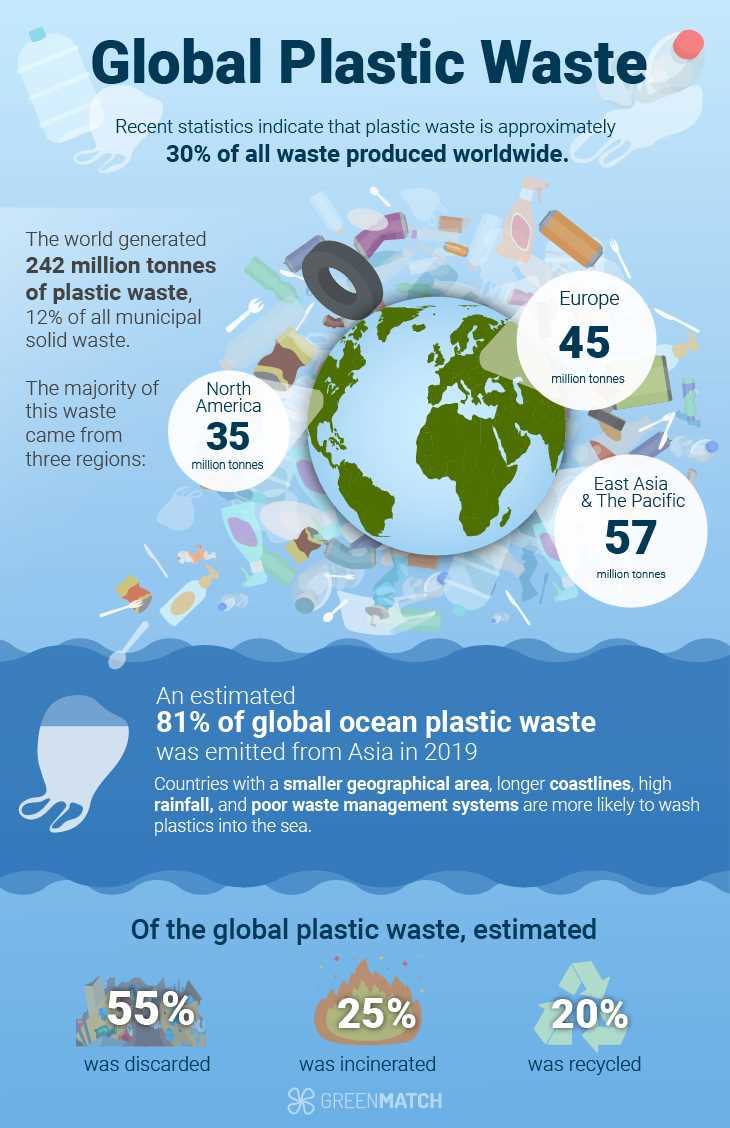
Plastic waste has become one of the biggest environmental challenges of our time. Every year, millions of tons of plastic are dumped into the oceans and landfills, causing immense harm to marine life and polluting our ecosystems. While plastic pollution is a global issue, there are certain countries that contribute more to this problem than others. Among them, one country stands out as the largest producer of plastic waste.
With its rapidly growing economy and massive population, China has become the biggest contributor to the world’s plastic waste crisis. According to a recent study, China alone is responsible for producing a staggering 28% of the world’s plastic waste. The country’s industrial and manufacturing sectors, as well as its booming consumer culture, have led to a massive increase in plastic consumption and waste generation.
This dominance in plastic waste production can be attributed to several factors. One of the main factors is China’s reliance on single-use plastic items, such as plastic bags, bottles, and food packaging. These items are used extensively in the country’s retail and food industries, contributing to the large amounts of plastic waste generated on a daily basis. Additionally, China’s inadequate waste management infrastructure and lack of recycling facilities further exacerbate the problem, as a significant portion of the plastic waste ends up in landfills or gets dumped into rivers and oceans.
The consequences of China’s plastic waste production are devastating. Not only does it harm marine life and pollute the environment, but it also poses serious health risks to the population. Plastic waste can release toxic chemicals when it breaks down, contaminating soil, water sources, and food supplies. This can lead to a wide range of health issues, including respiratory problems, hormone disruption, and even cancer.
- The Global Plastic Waste Problem
- Plastic Waste Statistics
- Table: Top 5 Plastic Waste Producing Countries
- Understanding Plastic Waste:
- Types of Plastic Waste:
- Causes of Plastic Waste:
- Impact of Plastic Waste:
- The Leading Producers:
- The Environmental Impact:
- Efforts to Reduce Plastic Waste:
- Q&A:
- Which country is the largest producer of plastic waste?
- Why is China the largest producer of plastic waste?
- What are the environmental consequences of China’s plastic waste production?
- What measures is China taking to curb its plastic waste production?
The Global Plastic Waste Problem
Plastic waste is a growing problem around the world, with significant environmental and health implications. The production and consumption of plastics have increased dramatically over the past few decades, leading to a surge in plastic waste generation. The improper disposal and management of plastic waste have contributed to its widespread presence in oceans, rivers, and landfills.
The global plastic waste problem has several dimensions – environmental, economic, and social. Plastic waste poses a threat to marine life, with millions of animals dying each year due to plastic ingestion or entanglement. Additionally, the accumulation of plastic waste in the oceans contributes to the formation of microplastics, which can enter the food chain and eventually impact human health.
Economically, the management and cleanup of plastic waste incur significant costs for governments and communities. It requires advanced recycling infrastructure, waste collection systems, and educational campaigns to reduce plastic consumption and promote responsible waste disposal. Developing countries often face more significant challenges in dealing with plastic waste due to limited resources and infrastructure.
Plastic Waste Statistics
According to recent data, the global production of plastics has exceeded 360 million metric tons per year, with China being the largest producer. However, many other countries contribute to the plastic waste problem as well. The United States, European Union countries, and Indonesia are among the top plastic waste producers globally.
Plastic waste management is a complex issue that requires multi-faceted solutions. Governments, industries, and individuals must work together to reduce plastic consumption, improve waste management systems, and promote the use of sustainable alternatives. Through collective efforts, we can address the global plastic waste problem and ensure a healthier future for our planet.
Table: Top 5 Plastic Waste Producing Countries
| Rank | Country | Plastic Waste Produced (Metric Tons) |
|---|---|---|
| 1 | China | Approximately 59.08 million |
| 2 | United States | Approximately 37.83 million |
| 3 | European Union | Approximately 27.09 million |
| 4 | Indonesia | Approximately 16.72 million |
| 5 | Philippines | Approximately 12.73 million |
Understanding Plastic Waste:
Plastic waste has become a growing concern worldwide due to its negative impact on the environment. Understanding the various aspects of plastic waste is crucial in finding sustainable solutions to this global problem.
Types of Plastic Waste:

Plastic waste can be categorized into different types based on their composition and characteristics. Some common types include:
- 1. Single-use plastics: These are items designed for one-time use, such as plastic bags, bottles, and straws.
- 2. Packaging materials: Plastic packaging used for food, electronics, and other consumer goods.
- 3. Microplastics: Tiny plastic particles often found in personal care products and created through the breakdown of larger items.
- 4. Fishing gear: Discarded fishing nets and equipment that pose a threat to marine life.
Causes of Plastic Waste:
The generation of plastic waste is influenced by various factors. Some of the major causes include:
- 1. Excessive production and consumption: The demand for plastic products has significantly increased, resulting in a higher production rate and consequently more waste.
- 2. Inefficient waste management: Lack of proper waste management systems and recycling facilities leads to improper disposal of plastic waste, causing it to end up in landfills or oceans.
- 3. Lack of awareness and education: Many people are unaware of the consequences of plastic waste and the importance of recycling, contributing to the problem.
Understanding the causes of plastic waste helps identify areas that require attention in order to reduce its generation and implement effective waste management practices.
Impact of Plastic Waste:
The accumulation of plastic waste has severe consequences for the environment and human health. Some key impacts include:
- 1. Environmental pollution: Plastic waste contaminates ecosystems, leading to the destruction of habitats and endangering wildlife.
- 2. Marine pollution: Plastic waste in oceans poses a significant threat to marine life, with marine animals often mistaking it for food or getting entangled in it.
- 3. Microplastic contamination: Microplastics have been found in various environments, including the air we breathe, and can enter the food chain, potentially harming human health.
- 4. Carbon emissions: The production and disposal of plastic waste contribute to greenhouse gas emissions, exacerbating climate change.
Understanding the far-reaching impacts of plastic waste reinforces the urgency of finding sustainable alternatives and implementing effective waste management strategies.
The Leading Producers:
When it comes to plastic waste, there are several countries that stand out as the leading producers. These countries have a combination of factors that contribute to their high levels of plastic waste production.
One of the leading producers of plastic waste is China. With its large population and robust manufacturing industry, China generates a significant amount of plastic waste on a daily basis. The country’s rapid economic growth and consumerism have led to increased demand for plastic products, resulting in a higher volume of plastic waste.
The United States is also one of the leading producers of plastic waste. Its high standard of living and culture of convenience contribute to the extensive use of single-use plastics. From plastic bottles and packaging to disposable utensils and straws, the US generates a substantial amount of plastic waste.
Other countries that rank among the leading producers of plastic waste include Japan, Germany, and Brazil. These countries have well-developed industrial sectors and high levels of plastic consumption, contributing to significant plastic waste production.
It is important to note that while these countries are the leading producers of plastic waste, they are also taking steps to address the issue. Efforts such as implementing recycling programs and promoting sustainable practices are being made to reduce plastic waste and its impact on the environment.
In conclusion, several countries are at the forefront of plastic waste production. The combination of large populations, industrial sectors, and high levels of plastic consumption contribute to their status as leading producers. However, it is crucial for these countries and the global community as a whole to prioritize sustainable practices and find innovative solutions to reduce plastic waste and protect our planet.
The Environmental Impact:
The massive production and consumption of plastic worldwide have a severe impact on the environment. Plastic waste poses a significant threat to marine life, terrestrial ecosystems, and human health.
One of the most pressing environmental issues caused by plastic waste is marine pollution. Plastic items such as bottles, bags, and microplastics are frequently mistaken for food by marine animals, leading to their ingestion and ultimately death. Additionally, discarded fishing gear, known as ghost nets, entangle marine creatures, causing injuries and preventing their normal movement.
Plastic waste not only harms marine life but also affects terrestrial ecosystems. Improper disposal of plastic items leads to their accumulation in landfills, releasing toxic substances into the surrounding soil and water sources. These toxins can contaminate the food chain, affecting plants, animals, and humans alike.
The production of plastic also contributes to greenhouse gas emissions and climate change. The extraction and refining of fossil fuels, which are used as raw materials for plastic production, release large amounts of carbon dioxide and other greenhouse gases into the atmosphere. Furthermore, the incineration of plastic waste releases toxic pollutants, including dioxins, furans, and carbon monoxide.
Plastic waste also poses a threat to human health. Many plastic products, such as food containers and water bottles, contain chemicals known as endocrine disruptors, which can interfere with hormonal balance and have adverse effects on reproductive health. Moreover, the ingestion of microplastics through contaminated food and water sources is a growing concern, as their long-term health impacts are not yet fully understood.
Addressing the environmental impact of plastic waste requires concerted efforts at the individual, community, and governmental levels. Recycling and waste management programs, as well as the promotion of sustainable alternatives to plastic, are essential steps towards reducing plastic pollution and safeguarding our planet’s health.
Efforts to Reduce Plastic Waste:

The problem of plastic waste has gained global attention, and many countries are taking measures to reduce their plastic consumption and waste production. Several initiatives and efforts have been implemented to combat the issue of plastic pollution:
1. Plastic bag bans: Many countries and cities have implemented regulations to reduce the use of plastic bags. Bans or taxes on single-use plastic bags have been put in place to encourage consumers to switch to reusable bags or other alternatives.
2. Recycling programs: Governments and organizations have been promoting recycling programs to encourage the proper disposal of plastic waste. Recycling facilities and collection systems have been established to ensure that plastic waste is recycled instead of ending up in landfills or the ocean.
3. Extended producer responsibility: Some countries have implemented extended producer responsibility (EPR) policies, where manufacturers are held responsible for the entire lifecycle of their products, including the proper disposal and recycling of the packaging materials.
4. Plastic bottle deposits: Bottle deposit programs have been implemented in several countries as a way to encourage recycling and proper disposal of plastic bottles. Consumers pay a small deposit when buying a beverage, which they can reclaim by returning the empty bottle for recycling.
5. Public awareness campaigns: Governments and environmental organizations have been running public awareness campaigns to educate the public about the negative impacts of plastic waste and promote the adoption of sustainable alternatives.
6. Research and innovation: Many research institutions and companies are investing in research and development to find innovative solutions to reduce plastic waste. This includes exploring alternative materials, improving recycling technologies, and developing biodegradable plastics.
While these efforts are helping to address the problem, there is still a long way to go in reducing plastic waste globally. Collaboration between governments, businesses, and individuals is crucial to finding sustainable solutions and preventing further harm to our environment.
Q&A:
Which country is the largest producer of plastic waste?
The largest producer of plastic waste is China.
Why is China the largest producer of plastic waste?
China is the largest producer of plastic waste due to its massive population and rapid economic development. As the country’s economy has grown, so has its consumption of plastic products.
What are the environmental consequences of China’s plastic waste production?
China’s plastic waste production has significant environmental consequences. It leads to pollution of land, rivers, and oceans, harming ecosystems and wildlife. Plastic waste also contributes to greenhouse gas emissions and exacerbates global warming.
What measures is China taking to curb its plastic waste production?
China is taking several measures to curb its plastic waste production. The government has implemented bans on single-use plastic products in major cities, enforced stricter waste management regulations, and encouraged the recycling and reuse of plastics. Additionally, public awareness campaigns are being carried out to educate the population about the importance of reducing plastic consumption.